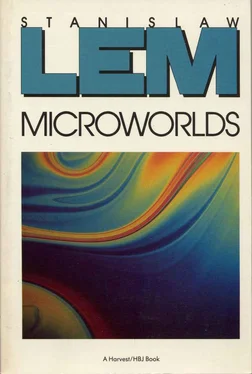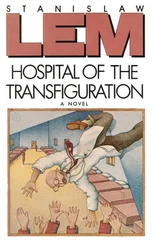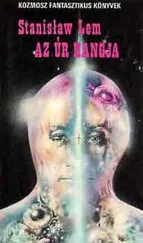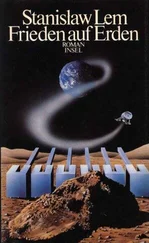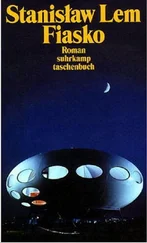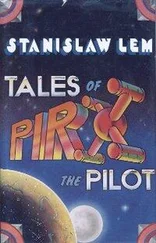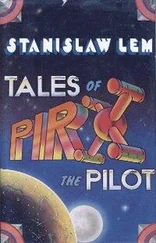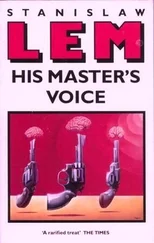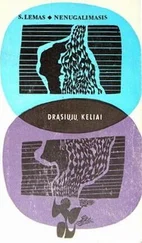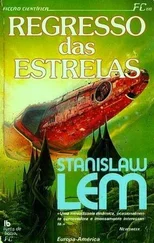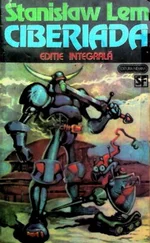It does not take long to explain why the authors silently passed our version of the landing by. It could not please them because it detracts from the work’s menacing and hence mysterious atmosphere. Still, their error lies in just this silence about the possibility of an accident. We understand quite well why they chose this course. In the meeting of the civilizations, both sides were meant to be discredited. Men agree on using the gift only in base and self-destructive ways because that is human nature; and the Senders prove their murderous indifference to humanity because beings of high intelligence do not give a damn about their intellectual inferiors. So extreme a version of the invasion theme would have deserved literary representation, all the more since it surpasses everything that science fiction has so far accomplished in this direction. But in that case the narrative would have had to rule out our hypothesis about the damaged gift; it would have had to bring it to grief from the outset — that is, it ought to have discredited it. Silence about it, on the other hand, though intended to consign our version to oblivion, constituted a mistaken authorial tactic.
From what has been said, conclusions of a more general nature arise with regard to the optimal strategy for dealing with the invasion theme. [20] We are presenting the hypothesis of the calamity in its simplest, which does not mean its most probable, version. For example, an unmanned spaceship with containers might have been sent forth without any fixed addressee in mind; it might have been outfitted with sensors that would recognize the planet to be “gifted” by virtue of predetermined parameters (such as its average temperature; its atmospheric composition, particularly the presence of free oxygen and water; an orbit favorable to ecological development; etc.). Such an automatically piloted vehicle could have approached various stars on a scouting mission. However, because it is physically impossible to manufacture technological products to survive undamaged over a journey of indeterminate length (which may take millions of earth-years), such a vehicle must have been provided with a device that would automatically destroy the contents when their “shelf life” had ended. Such a vehicle could have entered our solar system as the “shelf life” of the articles was nearing the expiry date. After all, it could also have been that the self-destruction did not occur only because the ship’s surveillance system discovered earth and dispersed the containers with their “partially spoiled” contents. The degree of damage to individual surveillance, steering, and control systems is uncertain; only the statistical probability of damage can be determined — i.e., the one thing absolutely certain is that the probability of defects occurring in the programs and their execution system increases with the passage of time. I should emphasize this point: the more complicated a device, the more inevitable are breakdowns over the course of time; this is a universal law that is independent of where in the cosmos the technology was produced or how. Therefore, the enterprise of learning about the aliens — what the Strugatskys call “xenology” — must take the statistical-probability aspect of intercivilizational contact into account as something crucial for interpreting such visits.
In order to carry out the strategy of preserving the mystery, two requirements have to be rigorously fulfilled. First of all, the author must not arouse the suspicion that certain facts are being hidden from the reader, facts beknown to the fictive heroes (all of Roadside Picnic’s protagonists must know, for example, whether another Zone, aside from the one in Harmont, also lies within a city’s limits). The reader must remain convinced that the information the author imparts is, within the limits of possibility, complete. The mystery then will be kept hidden by the very unfolding and presentation of the depicted events, which create, as it were, an impenetrable mask behind which no one can see. Otherwise this effect can be achieved only through a very precise balancing of the facts. They may neither point in one direction too unequivocally, nor overwhelm us by being all too chaotically diffuse. What they attest to must remain undecided, on the divide, as it were, between diverging alternatives, without inclining definitively toward any one side.
Now our excellent authors have defeated their own purposes by maligning the visitors at the end of their story. That the Golden Ball is supposed to fulfill wishes is, of course, a naïve belief, one of those popular legends that rose up in the wake of the visit. It was clear to the authors that they could not make an infernal machine out of this Ball, since that would have been an exaggeration that would have changed the meaning of their book: it would have transformed the Zone from something ambiguous, albeit dismal, into an unequivocal trap for humankind. Therefore they made the Golden Ball into an almost neutral object and let death stand not in it, but right beside it, as a “transparent emptiness that was lurking in the shadow of the excavator’s bucket” (4:143), a nothingness that throttles Arthur before Redrick’s eyes. Comparing the first expedition into the Zone that Redrick undertakes (together with Panov) with the last (which, in the company of Arthur, leads to the Golden Ball), one recognizes that the latter adventure has the structure of a “black fairy tale.” The fairy-tale quality is not difficult to spot: like a valiant knight-errant seeking the elixir of life or a magic ring, the heroes must overcome dreadful and dangerous obstacles while striving toward a highly valued treasure. Furthermore, Redrick knows that the approach to the Golden Ball is barred by a mysterious “grinder” (4:130), which one must “satiate” by bringing it a human sacrifice. That is why he lets Arthur be the first to approach the sphere — and in fact Arthur dies before his eyes, and his death momentarily breaks the evil spell, so that Redrick in his turn can then reach the Golden Ball. At that point, the authors break off the table and subscribe the word “finis.” This, however, is a way out which merely attenuates the shape of things without altering it.
The authors claim — and I have discussed this point with them — that the convergence in the Golden Ball of fairy-tale motif and the Horrific originates solely in the human mind and is a product of chance and human fantasy. Yet, as we have previously stated, one must not arrange all too many “coincidences” that all point in one and the same direction; for it then becomes incredible that they came about by chance. Besides, the last expedition into the Zone does not have the generic attributes of science fiction. The realistic frame for the events transforms itself into that of a fairy tale, [21] The degree to which the authors followed the fairy tale’s structural pattern in their epilogue can, for example, be seen in the passage in which “black twisted stalactites that looked like fat candles” (4:141) are mentioned. These are all that is left of the people the Golden Ball has killed — that is, all that is left of Redrick’s and Arthur’s predecessors in the quest for the accursed treasure. In fairy tales such remains — the bones of daredevils who ran out of luck — usually lie at the entrance of the dragon’s cave, at the foot of the glass mountain, etc.
because the “coincidences” following one upon the next amount, as we have already observed, to the stereotypic quest for the accursed treasure, though they ought not be identical with any stereotype. The mystery is not consistently preserved to the very end; behind it, the truth keeps shimmering through, since we no doubt have an idea about who the visitors are: they are, once more, monsters, albeit invisible monsters.
Читать дальше
